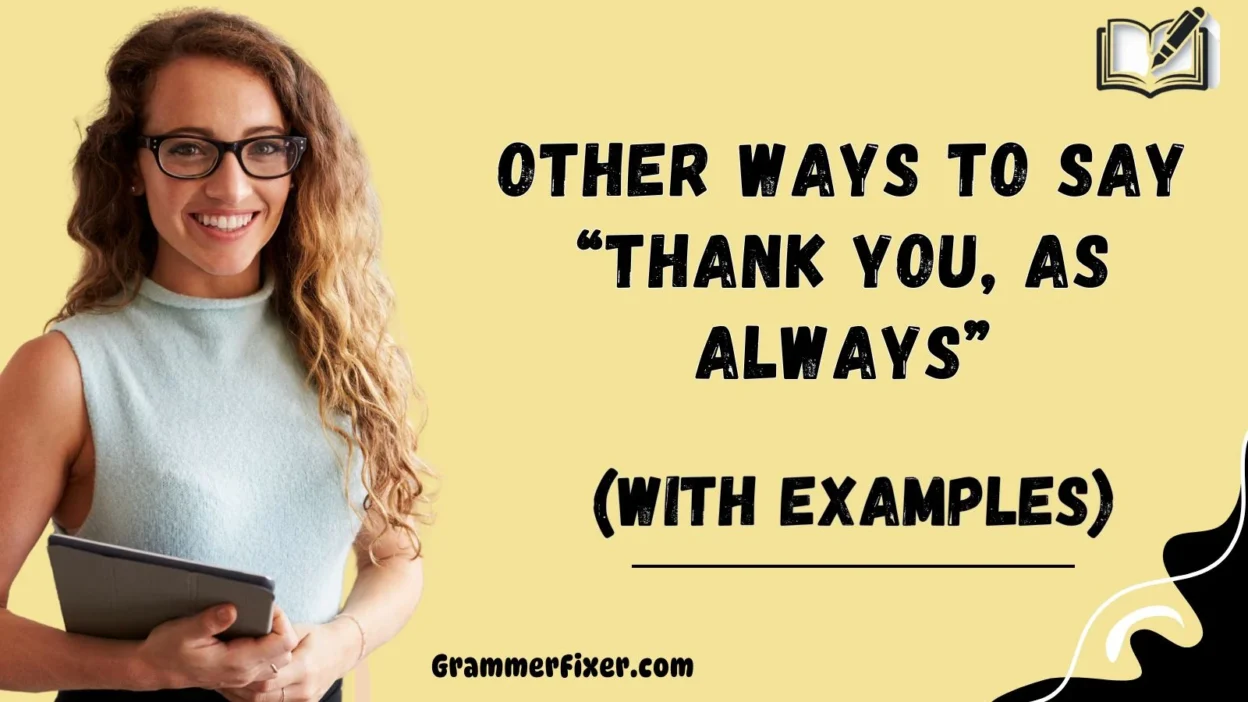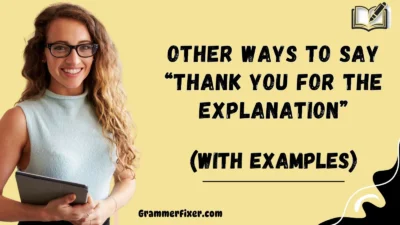Finding the right words to express gratitude can make all the difference in how your message is received. The phrase “Thank You, as Always” is warm and reliable, but sometimes, varying your language adds a touch of authenticity, thoughtfulness, and professionalism.
Below, you’ll find 30 meaningful alternatives—complete with explanations, tone, and examples—so you can communicate with both empathy and clarity in every interaction.
What Does “Thank You, as Always” Mean?
The phrase means you’re showing appreciation not just for one action but for someone’s consistent support, reliability, or kindness. It implies gratitude beyond a single event, acknowledging a pattern of trust and helpfulness.
When to Use “Thank You, as Always”?
You can use it when:
- Thanking a colleague who consistently provides help.
- Appreciating a friend or family member who is always present.
- Writing in a professional email to highlight ongoing support.
- Acknowledging reliability in repeated tasks, meetings, or guidance.
Is It Professional/Polite to Say “Thank You, as Always”?
Yes. The phrase is polite, professional, and conveys warmth. It works well in both formal and semi-formal communications because it feels heartfelt without being overly casual.
Pros or Cons
Pros:
- Conveys consistency and trustworthiness.
- Shows thoughtful appreciation.
- Works in professional and personal contexts.
Cons:
- Can feel repetitive if overused.
- May sound routine rather than personalized if used too often.
1. Always Grateful for Your Support
Meaning: Expresses deep, ongoing gratitude.
Explanation: Highlights consistent appreciation for ongoing help or reliability.
Scenario Example:
“Always grateful for your support during these project deadlines.”
Best Use: Professional emails, client relationships.
Worst Use: In overly casual chats or text messages—it can sound too formal and stiff.
Tone: Sincere, professional, steady.
2. Thank You Endlessly
Meaning: Shows limitless appreciation.
Explanation: Suggests that your gratitude is boundless.
Scenario Example:
“Thank you endlessly for being so approachable with your guidance.”
Best Use: Warm notes to colleagues, mentors.
Worst Use: In official business documents or contracts—it may feel unprofessional.
Tone: Emotional, heartfelt.
3. Forever Thankful
Meaning: A way to say gratitude will never fade.
Explanation: Ideal for strong, lasting relationships.
Scenario Example:
“I’m forever thankful for the patience you show in every meeting.”
Best Use: Professional yet personal exchanges.
Worst Use: When addressing clients formally—may come across as overly emotional.
Tone: Steady, appreciative.
4. Continually Grateful
Meaning: Appreciation that is ongoing.
Explanation: Conveys a sense of constant acknowledgment.
Scenario Example:
“I’m continually grateful for your insightful feedback.”
Best Use: Suitable for colleagues, managers, peers.
Worst Use: In casual banter—it may feel unnatural or forced.
Tone: Professional, consistent.
5. Thank You, Time and Again
Meaning: Gratitude for repeated efforts.
Explanation: Highlights appreciation for ongoing reliability.
Scenario Example:
“Thank you, time and again, for helping us meet deadlines smoothly.”
Best Use: Recurrent professional interactions.
Worst Use: When used in very formal or legal contexts—it can sound too conversational.
Tone: Warm, dependable.
6. Ever Appreciative
Meaning: Expresses appreciation that never stops.
Explanation: Conveys that your gratitude is ever-present and enduring.
Scenario Example:
“I’m ever appreciative of the guidance you provide in our weekly reports.”
Best Use: Professional contexts where steady appreciation is important.
Worst Use: In casual conversations with friends—it can sound stiff or insincere.
Tone: Professional, graceful.
7. With Deep Gratitude
Meaning: Shows profound and heartfelt thanks.
Explanation: Adds depth and emotional sincerity to your acknowledgment.
Scenario Example:
“I write this with deep gratitude for your mentorship during this project.”
Best Use: Formal letters, professional acknowledgments.
Worst Use: Quick emails or texts—it may come across as overly heavy.
Tone: Formal, heartfelt.
8. Thanks, As Always, for Your Guidance
Meaning: Directly acknowledges ongoing mentorship or advice.
Explanation: Reinforces gratitude for someone’s role as a guide or advisor.
Scenario Example:
“Thanks, as always, for your guidance—it makes all the difference.”
Best Use: Professional messages to mentors, managers.
Worst Use: With peers or casual colleagues—it can feel overly deferential.
Tone: Respectful, appreciative.
9. Grateful Beyond Words
Meaning: Expresses that gratitude is so immense it can’t be fully described.
Explanation: A highly emotional and impactful expression.
Scenario Example:
“I’m grateful beyond words for your patience and understanding.”
Best Use: Meaningful professional or personal acknowledgments.
Worst Use: Overly formal corporate documents—it can feel exaggerated.
Tone: Heartfelt, emotional.
10. Sincerely Appreciative
Meaning: A genuine and straightforward way of expressing thanks.
Explanation: Shows that your gratitude is authentic and unpretentious.
Scenario Example:
“I’m sincerely appreciative of your consistent collaboration.”
Best Use: Professional emails, respectful acknowledgments.
Worst Use: In highly casual chats—it may come across as overly formal.
Tone: Professional, sincere.
11. Thankful for Your Steadfast Support
Meaning: Recognizes reliability and unwavering help.
Explanation: Highlights the value of someone’s consistent dependability.
Scenario Example:
“I’m thankful for your steadfast support throughout these challenges.”
Best Use: Professional settings where loyalty and reliability are key.
Worst Use: Casual notes to friends—it can sound too stiff.
Tone: Formal, respectful.
12. My Continued Thanks
Meaning: Gratitude that is ongoing and enduring.
Explanation: Suggests that your thanks extend beyond the moment.
Scenario Example:
“Please accept my continued thanks for your constructive feedback.”
Best Use: Written correspondence, recurring communications.
Worst Use: In spontaneous verbal exchanges—it can sound scripted.
Tone: Steady, professional.
13. With Constant Appreciation
Meaning: Suggests unfailing gratitude.
Explanation: Ideal when someone is consistently helpful.
Scenario Example:
“I send this note with constant appreciation for your teamwork.”
Best Use: Emails to long-term collaborators.
Worst Use: One-off or first-time interactions—it may feel premature.
Tone: Warm, consistent.
14. Much Obliged, As Always
Meaning: A polite, slightly formal expression of thanks.
Explanation: Conveys gratitude in a traditional and professional way.
Scenario Example:
“I’m much obliged, as always, for your timely response.”
Best Use: Formal correspondence, traditional workplaces.
Worst Use: In modern, casual settings—it may feel outdated.
Tone: Formal, courteous.
15. Ever Thankful
Meaning: Communicates endless gratitude.
Explanation: Suggests a strong, ongoing bond of appreciation.
Scenario Example:
“I remain ever thankful for your encouragement during tough times.”
Best Use: Personal and professional bonds with depth.
Worst Use: In short transactional messages—it can feel too emotional.
Tone: Heartfelt, steady.
16. Truly Grateful
Meaning: A simple yet strong way to express genuine appreciation.
Explanation: Conveys authenticity and sincerity in a clear, professional tone.
Scenario Example:
“I am truly grateful for your consistent encouragement.”
Best Use: Professional messages where you want to emphasize sincerity.
Worst Use: Overly casual conversations—it may sound formal and heavy.
Tone: Authentic, professional.
17. Thank You Consistently
Meaning: Gratitude that reflects ongoing support.
Explanation: Suggests appreciation for repeated actions rather than one event.
Scenario Example:
“Thank you consistently for your quick responses on project updates.”
Best Use: Professional communication with colleagues and teams.
Worst Use: In personal or lighthearted notes—it feels unnatural.
Tone: Professional, steady.
18. With Lasting Appreciation
Meaning: Gratitude that endures over time.
Explanation: Adds a sense of longevity and depth to your thanks.
Scenario Example:
“I hold you in lasting appreciation for the mentorship you’ve provided.”
Best Use: Formal letters, thank-you notes, mentorship acknowledgments.
Worst Use: Quick chats or instant messages—it may feel too weighty.
Tone: Formal, respectful.
19. Thankful as Ever
Meaning: Suggests your level of gratitude never changes.
Explanation: Reinforces ongoing appreciation in a friendly, approachable tone.
Scenario Example:
“I’m thankful as ever for your consistent help with deadlines.”
Best Use: Friendly professional emails, semi-formal notes.
Worst Use: In highly formal situations—it may sound casual.
Tone: Warm, approachable.
20. Always Thankful for Your Efforts
Meaning: Highlights continued gratitude for someone’s hard work.
Explanation: Acknowledges effort, dedication, and commitment.
Scenario Example:
“I’m always thankful for your efforts in guiding this project forward.”
Best Use: Team appreciation, workplace communication.
Worst Use: Personal notes to family or friends—it feels overly formal.
Tone: Professional, encouraging.
21. Thanks, As Usual
Meaning: A casual version of “Thank You, as Always.”
Explanation: Conveys friendly acknowledgment of someone’s consistent behavior.
Scenario Example:
“Thanks, as usual, for catching those small errors in the report.”
Best Use: Friendly workplace banter, peer-to-peer appreciation.
Worst Use: In formal or client-facing communication—it can sound dismissive.
Tone: Casual, approachable.
22. Grateful as Always
Meaning: Similar to the original phrase, but slightly more concise.
Explanation: Keeps the warmth while sounding more professional and refined.
Scenario Example:
“I’m grateful as always for your continued reliability.”
Best Use: Professional emails, ongoing collaborations.
Worst Use: Casual texts—it may sound overly formal.
Tone: Polite, professional.
23. Forever Appreciative
Meaning: Expresses enduring and permanent gratitude.
Explanation: Highlights a lasting bond of appreciation.
Scenario Example:
“I’ll be forever appreciative of your generous guidance.”
Best Use: Long-term mentorship, important acknowledgments.
Worst Use: Routine workplace updates—it can feel exaggerated.
Tone: Heartfelt, respectful.
24. My Ongoing Thanks
Meaning: A way to show thanks that continues over time.
Explanation: Reinforces that your gratitude is recurrent.
Scenario Example:
“Please accept my ongoing thanks for your reliable support.”
Best Use: Professional correspondence, follow-ups.
Worst Use: Casual conversations—it can sound mechanical.
Tone: Professional, steady.
25. With Unfailing Gratitude
Meaning: Gratitude that is steady and unwavering.
Explanation: Adds depth and seriousness to your acknowledgment.
Scenario Example:
“I hold you in unfailing gratitude for your commitment to this project.”
Best Use: Formal notes, leadership acknowledgments.
Worst Use: Informal chats—it may sound too dramatic.
Tone: Formal, profound.
26. As Always, Thank You Kindly
Meaning: A warm, polite expression of appreciation.
Explanation: Adds a touch of kindness and courtesy.
Scenario Example:
“As always, thank you kindly for your timely feedback.”
Best Use: Semi-formal professional emails, respectful interactions.
Worst Use: High-stakes formal writing—it may feel too casual.
Tone: Polite, warm.
27. Much Appreciated, as Ever
Meaning: Friendly acknowledgment of repeated efforts.
Explanation: Keeps gratitude light but genuine.
Scenario Example:
“Your quick help is much appreciated, as ever.”
Best Use: Friendly exchanges among colleagues.
Worst Use: Strictly formal correspondence—it may feel informal.
Tone: Casual, genuine.
28. With Enduring Thanks
Meaning: Thanks that continues through time.
Explanation: Conveys depth and lasting appreciation.
Scenario Example:
“I extend this message with enduring thanks for your mentorship.”
Best Use: Formal acknowledgments, speeches, professional letters.
Worst Use: Everyday quick replies—it can sound too heavy.
Tone: Formal, thoughtful.
29. My Thanks, Ongoing as Always
Meaning: Combines ongoing gratitude with the familiar tone of the original phrase.
Explanation: A unique phrasing that emphasizes reliability and consistency.
Scenario Example:
“Please know you have my thanks, ongoing as always, for your collaboration.”
Best Use: Written professional notes, reports.
Worst Use: Verbal, casual settings—it can sound awkward.
Tone: Professional, steady.
30. Always Appreciate Your Efforts
Meaning: Highlights continuous gratitude for hard work.
Explanation: Reinforces someone’s role as a reliable contributor.
Scenario Example:
“I always appreciate your efforts in ensuring projects stay on track.”
Best Use: Workplace recognition, team communication.
Worst Use: Formal documents or legal writing—it may feel too personal.
Tone: Professional, encouraging.
Conclusion
The phrase “Thank You, as Always” is timeless, but variety helps your words feel more authentic, professional, and empathetic. These 30 alternatives give you the flexibility to adapt your tone, formality, and context—whether you’re writing a quick email, expressing gratitude to a mentor, or appreciating a team’s effort.



